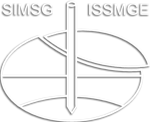Discrete element modelling of centrifuge experiments on pile jacking
Discrete element modelling of centrifuge experiments on pile jacking
The cyclic behavior of pile foundations is studied using the Discrete Element Method (DEM) through simulated centrifuge experiments. The centrifugal acceleration enables reproducing real-scale problems on reduced models, while DEM provides access to microscopic information on the particles-structure interactions. First, a discrete model based on spherical particles involving elasticity, friction and rolling resistance is calibrated against monotonic, drained triaxial tests to reproduce the behavior of Fontainebleau NE34 sand. Then, the cyclic response of the material is evaluated by means of cyclic triaxial tests. Finally, the model is applied to a quasi 2D simplification (semi-infinite plate with periodic boundary conditions) of the behavior of a pile foundation. After an investigation of the effect of sample size and boundary conditions, the study tests different pile jacking techniques, monotonic and cyclic strokes, exploring their impact on the total of the shaft and tip resistance of the pile. The importance of installation velocity is investigated for each technique. The geometry of future experiments in the geotechnical centrifuge is presented in this work and used as a basis for the numerical simulations. In conclusion, this research provides important information about the impact of different modes of installation on pile foundation behavior.
Alice Ezzeddine; Bogdan Cazacliu; P. Richard; Riccardo Artoni; Luc Thorel
18th European Conference on Soil Mechanics and Geotechnical Engineering (ECSMGE2024)
D - Current and new construction methods
